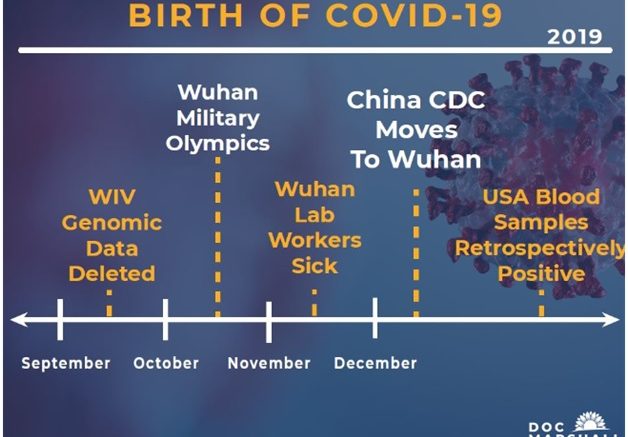The Chinese wet market hypothesis for COVID origins was always a house of cards. Why? Because not surprisingly, the data used to make the link between COVID and the wet market was biased and incomplete.
On August 24, 2023, Virus Evolution stated that the role of the Huanan Seafood Wholesale Market (HSWM) regarding the SARS-CoV-2 outbreak remains unclear. “Unclear” is a convenient conclusion given the goal to “muddy the waters” of the Proximal Origins story. But if you actually read the article, author Jason D. Bloom states that there is no real link between SARS-CoV-2 & the wet market.
That’s because the SARS-Cov-2 virus was hatched in a lab.
You might think there is strong scientific evidence for the so-called zoonotic spillover “wet market” hypothesis, given that proponents of the theory drew a conclusion that the Huanan Seafood Market was the “epicenter” of the pandemic. However, the most important evidence relied on incomplete data from the World Health Organization. Personally, I think the idea of a wet market comes from the 2011 movie script Contagion.
In contradiction to the theory, Chinese scientists published papers reporting that some of the earliest identified human cases in December 2019 had no link to the Huanan Seafood Market. Despite the fact that not all the cases were linked to the Huanan market, by January 1, 2020, the Wuhan Health Commission made a link to the market a criterion for reporting the new disease.
Thus began a debate that continues to this day: Was the market an initial source of zoonotic infections from animals, or was it simply a superspreading site that amplified earlier human infections from another source other than the market?
Unfortunately, there was no attempt to trace earlier cases as part of a retrospective reporting effort that might have helped pinpoint the pandemic’s origins, writes Michael Balter in his Substack.
Meanwhile, initial reports from Chinese officials described patients associated with the Huanan Seafood Market with no evidence of significant human-to-human transmission. The implication was that the infections likely originated from a non-human source within the market. But by mid-to-late January 2020, it was clear that SARS-CoV-2 was spreading from human to human and had been for some time.
Despite this contradictive information, it was universally accepted there were human cases of SARS-CoV-2 at the Huanan Seafood Market in mid-December 2019 and that some animals susceptible to SARS-CoV-2 were sold at the market. By the way, claims that raccoon dogs might have been the intermediate host present at the market have largely collapsed upon closer analysis.
While stories around Patient Zero are always fuzzy, the first fatal human case supposedly had continuous exposure to the market and was admitted to the hospital because of a 7-day history of fever, cough, and dyspnoea. Five days after the illness onset, his wife, a 53-year-old woman who had no known history of exposure to the market, also presented with pneumonia and was hospitalized in the isolation ward. Initially, patients presented with fever, dry cough, dyspnoea, and bilateral ground-glass lung opacities on chest CT scans. In other reports, it was stated that the first human infections with SARS-CoV-2 in Wuhan probably occurred no later than November 2019. Recall that initial cases in China were described as Pneumonia of Unknown Etiology (PUE), which would also mean the outbreak had nothing to do with the wet market.
The WHO however reported that “most of the unexplained viral pneumonia cases in Wuhan had a history of exposure to the South China seafood market, and that “no clear evidence of human-to-human transmission has been found.”
Strange contradictions. Think muddied waters.
Meanwhile, Balter points out that any biases in the data here would have also been exacerbated by the fact that simultaneous with the COVID-19 outbreak was an unusually active winter flu season.
Mismosh Of Genetic Material Contain Little or No SARS-CoV-2 Reads
In early 2022, the Chinese CDC collected samples from both the environment and animal/animal products. They reported that none of the 457 animal samples tested positive for SARS-CoV-2, but that 73 of 923 environmental samples tested positive. Additionally, the SARS-CoV-2 content of the environmental samples is generally very low: only 21 of 176 samples contain more than ten SARS-CoV-2 reads, despite most samples being sequenced to depths exceeding 108 total reads.
Keep in mind the samples were taken at least a month after the first human infections in Wuhan.
“Despite this significant caveat, the data reported in the Chinese CDC study have been variously interpreted to support arguments that the virus in the market was human-derived, that the outbreak originated from live animals sold in the market, or that the virus spread among humans in Mahjong rooms or toilets in the market,” writes Virus Evolution.
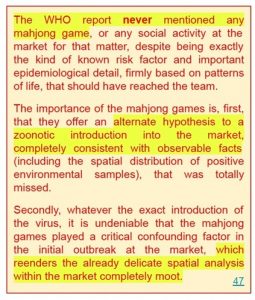 The passage here is written in a very confusing manner. Was that purposeful?
The passage here is written in a very confusing manner. Was that purposeful?
Incidentally, Mahjong is a tile-based game like Rummy and apparently, most of the early cases of COVID-19 involved mahjong players at the wet market, which was a major social gathering place for elderly residents of the area as well as employees of the market after they got off work. The mahjong rooms, which were semi-illicit and located near wildlife stalls, were very near toilets as well. Have you ever heard of mahjong players implicated with COVID-19 origins before?
Like with the Chinese CDC, the environmental samples taken for this paper contained genetic material from many species, including humans, various fish, various snakes, cows, goats, pigs, sheep, birds such as ducks and spotted doves, raccoon dogs, bamboo rats, and a long list of other animals.
So basically was this a mish-mash of genetic material from different species?
The author Jesse D. Bloom said he’s the first to provide a comprehensive analysis of the association between the abundance of SARS-CoV-2 and mitochondrial genetic material across all environmental samples. What was revealed is that the greatest co-mingling of viral and animal material involves species that were almost certainly not infected by SARS-CoV-2, such as fish (e.g. largemouth bass and catfish) and livestock (e.g. cows, sheep, and goats).
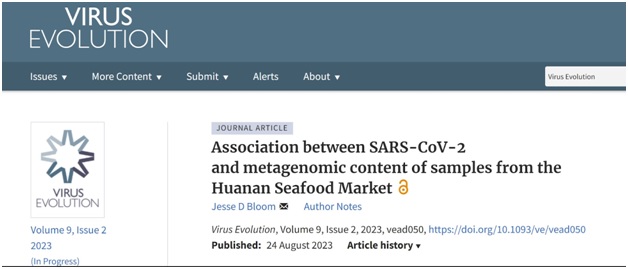
Consistent with analyses by the Chinese CDC, Bloom found some correlation between the abundance of SARS-CoV-2 and human genetic material, but this correlation is weaker than for several non-infectable animals.
Bloom says; “And so on its own, this is insufficient to identify the source of the viral material. Mitochondrial material from most susceptible non-human species sold live at the market is negatively correlated with the presence of SARS-CoV-2.”
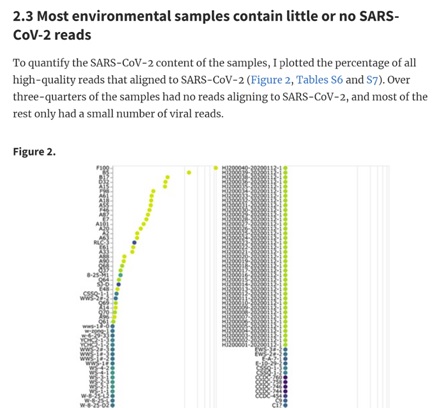 In conclusion, Bloom writes that these results suggest that while metagenomic analysis of the environmental samples is useful for identifying animals or animal products sold at the market, “co-mingling of animal and viral genetic material is unlikely to reliably indicate whether any animals were infected by SARS-CoV-2.”
In conclusion, Bloom writes that these results suggest that while metagenomic analysis of the environmental samples is useful for identifying animals or animal products sold at the market, “co-mingling of animal and viral genetic material is unlikely to reliably indicate whether any animals were infected by SARS-CoV-2.”
Bloom’s results suggest that SARS-CoV-2 was widespread in the market by January 2020 and therefore that the co-mingling of viral and animal genetic material in environmental samples collected at that time is unlikely to be informative about the original source of the outbreak.
According to a recent Morning Consult poll, nearly half of Americans (now) think the COVID-19 pandemic was caused by a lab leak in China.
Notes:
*On 29 March 2023, the Chinese CDC released raw deep sequencing data for samples taken from the Huanan Market in early 2020. These data were released on the NGDC database under accession CRA010170.
*Bloom is on the scientific advisory boards of Apriori Bio, Aerium Therapeutics, Invivyd, and the Vaccine Company; consults for GSK; and receives royalty payments as an inventor on Fred Hutch licensed patents related to deep mutational scanning of viral proteins.
++++++++++++++++++++++++++++++++
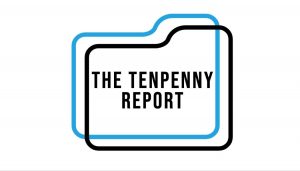 Like what you’re reading on The Tenpenny Report? Share this article with your friends. Help us grow.
Like what you’re reading on The Tenpenny Report? Share this article with your friends. Help us grow.
Get more of Dr. Tenpenny’s voice of reason at her website.
Join our list here
++++++++++++++++++++++++++++++++
Maryam Henein is an investigative journalist, and founder, and editor-in-chief of the health magazine and marketplace HoneyColony. She is also a functional medicine consultant/coach, and the director of the award-winning documentary film Vanishing of the Bees, narrated by Elliot Page. Follow her on Twitter @maryamhenein. Email her: maryam@honeycolony.com.

